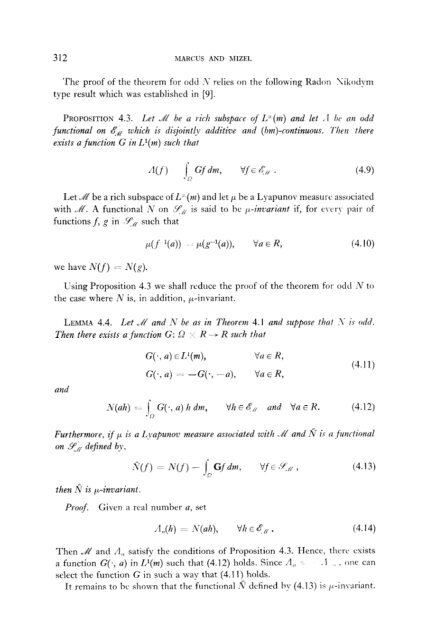Extension Theorems of Hahn-Banach Type for Nonlinear Disjointly ...
Extension Theorems of Hahn-Banach Type for Nonlinear Disjointly ...
Extension Theorems of Hahn-Banach Type for Nonlinear Disjointly ...
Create successful ePaper yourself
Turn your PDF publications into a flip-book with our unique Google optimized e-Paper software.
312 MAKCUS AND MIZEL<br />
The pro<strong>of</strong> <strong>of</strong> the theorem <strong>for</strong> odd S relies on the following Radon Sikodyn<br />
type result which was established in [9].<br />
PROPOSITION 4.3. Let ,//I’ be a rich subspace <strong>of</strong> L=(m) and let ‘1 be an odd<br />
functional on ~?j[ uhich is disjointly additive and (bm)-continuous. Then there<br />
exists a function G in Ll(m) such that<br />
Let A! be a rich subspace <strong>of</strong> L%(m) and let p be a Lyapunov measure associated<br />
with A?. A functional X on my,/ is said to be t”-invariant if, <strong>for</strong> ever!. pair <strong>of</strong><br />
functions f, g in .y,[ such that<br />
we have N(f) == X(g).<br />
t4.f ‘(4) P.(‘TW), VaER, (4. IO)<br />
Using Proposition 4.3 we shall reduce the pro<strong>of</strong> <strong>of</strong> the theorem <strong>for</strong> odd ;V to<br />
the case where N is, in addition, p-invariant.<br />
LEMMA 4.4. Let ,k/ and JV be as in Theorem 4.1 and suppose that S is odd.<br />
Then there exists a function G: Q K R --f R such that<br />
and<br />
G(., a) EL’(m), tin E R,<br />
G(., a) r= -G(*, -a), Va E R,<br />
(4.11)<br />
,V(ah) =~. 1. G(., a) 17 dm, Qh E &,, and VaER. (4.12)<br />
I “0<br />
Furthermore, if p is a LJ,apunov measure associated with & and fi is a Sfunrtional<br />
on 9’;( defked by,<br />
then fi is p-invariant.<br />
Pro<strong>of</strong>. Given a real number a, set<br />
A,,(h) = h:(ah), Q’h E cl’,, . (4.14)<br />
Then A! and A,, satisfy the conditions <strong>of</strong> Proposition 4.3. Hence, there exists<br />
a function G(., a) in Ll(m) such that (4.12) holds. Since A,, mu I 1 ,, . one can<br />
select the function G in such a way that (4.11) holds.<br />
It remains to be shown that the functional 2%’ defined by (4.13) is ~-invariant.

















